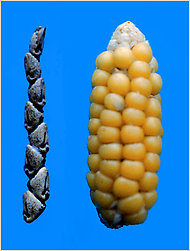Question
Answer
Expert response from Fran Castle
Former Global Senior Manager, Communications, BASF
Wednesday, 03/12/2014 12:24
 Have you ever heard of teosinte? This grassy plant is the precursor to corn, or maize. About 10,000 years after farmers in what is now Mexico took the first steps to domesticate the plant by simply choosing the most desirable kernels to plant, corn now provides about 21 percent of human nutrition across the globe. The history of the modern ear of corn is long and rich.
Have you ever heard of teosinte? This grassy plant is the precursor to corn, or maize. About 10,000 years after farmers in what is now Mexico took the first steps to domesticate the plant by simply choosing the most desirable kernels to plant, corn now provides about 21 percent of human nutrition across the globe. The history of the modern ear of corn is long and rich.
Farmers have intentionally changed the genetic makeup of all of the crops they have grown since domestic agriculture began. Every fruit, vegetable and grain that is commercially available today has been altered by human hands, including organic and heirloom seeds.
Often when people ask about genetically modifying foods, they refer to “GMOs.” A GMO is a plant developed through a process in which a copy of a desired gene or a section of genetic material from one plant or organism is placed in another plant, or by turning off or moving an existing gene. The only GMOs commercially available in the United States are the following nine crops: soybeans, corn (field and sweet), papaya, canola, cotton, alfalfa, sugar beets, potato and summer squash.
In another response, I discuss the history of genetic modification (in terms of moving genetic material in the form of DNA from one organism to another), and here is an excerpt:
“Nature is the master of genetic shuffling and is constantly sorting and resorting DNA, causing both subtle and profound changes in all living things. People first began their own DNA management thousands of years ago, when they began cross-breeding plants to produce better foods or fiber. In 1953, scientists discovered the structure of DNA, and in 1973, researchers developed a method for cutting and splicing DNA. That method became known as recombinant DNA, or rDNA, because it enabled scientists to cut and recombine segments of DNA. Since then, researchers have learned how to move genetic material in the form of DNA from one plant or animal to another.
“Genetic modification is much more precise than selective breeding. By transferring only certain genes from one plant or animal to another, researchers can introduce one specific trait without also transferring dozens of unwanted traits, as often occurs in selective breeding. And genetic modification is the only existing tool available for producing certain vaccines, drugs and diagnostics. Genetic modification in plants has been going on since the early 1980s. In 1986, EPA approved commercial growing of the first genetically engineered crop — tobacco plants resistant to a tobacco virus.”
If you have any additional questions, please ask.